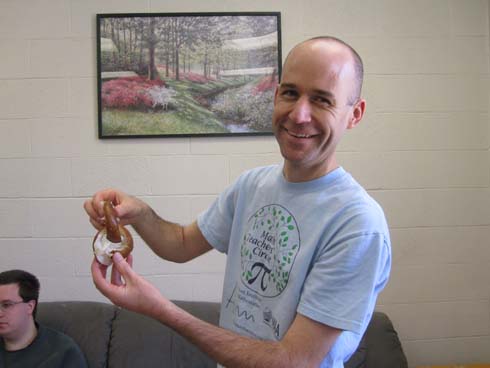 Dr. Robert Klein brought a bagel challenge on Pi Day.
Dr. Robert Klein brought a bagel challenge on Pi Day.
Pies—pizza pies, blueberry pies, custard pies and more—were devoured on March 14 in honor of Pi Day (3.14). Math students displayed posters highlighting their research, and Dr. Robert Klein’s bagel challenge had students going round and round.
Master’s student Ian Hogan—knife and bagel in hand—knew the concept: a Mobius strip, a surface with only one side. But he fought a losing battle with a brittle bagel while trying to cut the bagel into linking rings. Watch Hogan’s attempt at bagel carving. Klein, Associate Professor of Mathematics in the College of Arts & Sciences, denied reports that the bagels he provided for students were less moist than the sample he had carved successfully at home.
Dr. Martin Mohlenkamp, Associate Professor and Graduate Chair, asked attendees for help selecting poster presentation awards in four categories: best use of pi; most high-tech presentation; lowest-tech poster, and coolest work.
Bismark Oduro, a Ph.D. student, won the “cool poster” award for “Mathematical Models of Chagas Disease,” a disease that causes disfigurement and death.
“Approximately 8 to 11 million people are infected with Chagas disease, and an estimated 10,000 people die each year. Chagas disease is endemic in rural South and Central America, where poorly constructed housing provides hiding places for the vectors,” says Oduro, whose research project models the possible transmission routes of the disease. The disease is mainly transmitted through the bite of insects from several species of so-called “kissing bugs,” which transmit the parasite Trypanosoma cruzi to hosts.
“The bugs live in cracks and holes of houses, chicken nests, coops and similar hiding places,” notes Oduro. In developing a mathematical model for the disease, Oduro identified numerous challenges, including multiple transmission routes, multiple species of insects, the geographical and feeding behaviors of the insects, and even alternative hosts. His model calculated susceptible individuals (not infected but at risk) as well as infective individuals (infected and capable of transmitting the disease).
Oduro plans to build models that make biologically realistic predictions about the dynamics of the disease and the effectiveness of possible control strategies. He plans to focus on Ecuador, where 6 million people are at risk and 230,000 are infected.
John Kirby, a Ph.D. student, won a pie plate and pastry roller for the best use of pi for his poster on “A New Family of Archimedean Copulas.”
“Copulas describe the dependence structure between random variables,” Kirby said, noting that Achimedean copulas allow for an interesting variety of different dependence structures. “Informally, a copula is a multivariate distribution formula with uniform marginal on {0,1}.”
Nathan Breitsch, an undergraduate student, won a pencil, the low-tech prize, for “Clustering in the Cell Cycle,” despite his artistic hand-lettered title.
Nate McClatchey, a Ph.D. student, won “high-tech” accolades for the her poster with cats on “Image Compression Using Tensor Decomposition.”



















One Comment